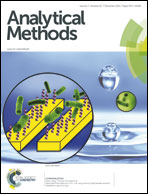An electrochemical biosensor for the activity assay of polynucleotide kinase and inhibitor screening
Abstract
A sensitive and selective electrochemical biosensor was fabricated for polynucleotide kinase (PNK) activity assay and inhibitor screening based on phos-tag-biotin mediated double signal amplification, where streptavidin and alkaline phosphatase-conjugated biotin (biotin-ALP) were used as the signal amplification units. After the immobilization of probe DNA on the electrode surface, it was hybridized with complementary DNA containing the 5′-OH terminal, the OH can be phosphorylated under the catalytic effect of PNK in the presence of ATP. The generated phosphate group at the 5′-terminal can be further recognized by phos-tag-biotin, where phos-tag-biotin was not only used as the specific recognition reagent for the phosphate group, but also the capture reagent for streptavidin to induce the further assembly of biotin-ALP. Under the catalytic effect of ALP, the substrate of p-nitrophenyl phosphate disodium salt hexahydrate (PNPP) can be hydrolyzed to produce p-nitrophenol (PNP). According to the relationship between the electrochemical response of PNP and the logarithmic value of PNK concentration, a linear range of 0.01–5 units per mL and a low detection limit of 0.0027 unit per mL were achieved. The developed method showed high selectivity. The inhibition effect of (NH4)2SO4 and Na2HPO4 was also evaluated and the IC50 values were calculated.


 Please wait while we load your content...
Please wait while we load your content...